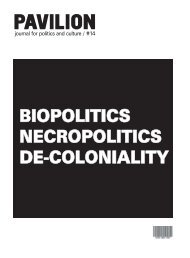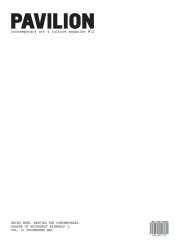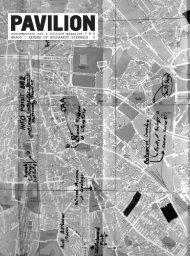Download pdf version of issue no. 16 (4 Mb) - Pavilion
Download pdf version of issue no. 16 (4 Mb) - Pavilion
Download pdf version of issue no. 16 (4 Mb) - Pavilion
Create successful ePaper yourself
Turn your PDF publications into a flip-book with our unique Google optimized e-Paper software.
[114]<br />
Rinus van de Velde<br />
untitled (The Lost Bishop)<br />
For his contribution to the Biennale <strong>of</strong><br />
Bucharest, Van de Velde will make a new,<br />
site-specific installation that consists <strong>of</strong> a<br />
series <strong>of</strong> black-and-white wall drawings in<br />
charcoal and a narrative text. Together, they<br />
tell a story based on the biography <strong>of</strong> Bobby<br />
Fischer (1943-2008), who is considered to<br />
be one <strong>of</strong> the greatest, but also most controversial<br />
chess players <strong>of</strong> all time.<br />
The drawings Van de Velde presents are<br />
based on existing photographs drawn from<br />
Fischer’s biography and other sources,<br />
which the artist then re-enacted within the<br />
confines <strong>of</strong> his studio, working with props,<br />
extras and himself as the protagonist. In<br />
doing so, Van de Velde imagines himself to<br />
be the main character <strong>of</strong> some one else’s<br />
story, which he appropriates and transforms.<br />
The narrative is based upon Fischer’s legendary<br />
victory in the 1972 World Championship<br />
in Reykjavik, where he defeated his<br />
Russian rival Boris Spasski in what has<br />
come to be k<strong>no</strong>wn as “the game <strong>of</strong> the century”.<br />
In Van de Velde’s retelling <strong>of</strong> the heroic<br />
story, Fischer becomes a chess-playing<br />
artist, a heroic but obsessive and worldstrange<br />
hero that controls a game he is<br />
completely absorbed by. The game <strong>of</strong> chess<br />
thus becomes a metaphor for a studiobased<br />
art practice that revolves around the<br />
ego <strong>of</strong> the artist and gives structure to the<br />
unsurpassable chaos <strong>of</strong> the ‘outside’ world,<br />
which consists <strong>of</strong> an abundance <strong>of</strong> images.<br />
The large-scale drawings ask the viewer to<br />
‘suspend their disbelief’ and literally step<br />
into the fictive story. At the same time, they<br />
reflect on the illusionistic function <strong>of</strong> drawing,<br />
storytelling, fantasy and romantic ideas<br />
<strong>of</strong> geniality and heroism. Although these are<br />
myths, Van de Velde suggests, they could<br />
still be considered to have a productive,<br />
self-realising value in the real <strong>of</strong> the outside<br />
world. (Koen Sels)<br />
Rinus van de Velde, untitled (The Lost Bishop), charcoal on wall 200 x 140 cm, 2012.<br />
Photo: Ben Van den Berghe. Courtesy <strong>of</strong> the artist and Ben Van den Berghe.<br />
[115]








